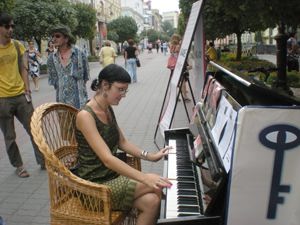Art en plein air,
or Cultural dialog in Ivano-Frankivsk
The international project “PORTO FRANKO-2010,” which combines visual art, music, photography, theater, cinema, and art cuisine from around the world, took place in the capital of Prykarpattia region. Nearly 100 artists from Poland, Iran, France and China came to the “port of Frankivsk” seeking spiritual enrichment, new know-ledge, fresh discoveries and creative dialog.
The festival organizers were, of course, inspired by Prokhasko’s essay Port Frankivsk. Taras Prokhasko, who lives in the historical center of Ivano-Frankivsk, called “PORTO FRANKO” his street’s very own holiday. Although nowadays it is called Independence Street, people usually call it just the Sotka or Stometrivka (hundred-meters street). One can often hear classical music, jazz, or violin solos, played there. During the week-long festival of global cultures, all citizens, visitors and tourists had a chance to become artists themselves, at least for a moment. Pianos were placed along the Sotka, and everyone willing to play some notes could. Cellos were heard in the Austrian-era mansions’ courtyards. In the cinema, the most persistent spectators watched a non-stop screening of artistic, documentary and animated films throughout The Day. And so on each day...
Franko restaurant took master classes by chefs from Iran, France and China.
An exhibition of contemporary art opened at Stanyslaviv fortress (partially reconstructed with private funding). The southwest bastion of the fortress was built in the middle of the 17th century by Andrzej Potocki, and is called sometimes the St. Andrew’s Bastion. It was used by the ‘inhabitants’ of the “art port Frankivsk” to access underground passages. The symbolic opening of the bastion was carried out by Taras Prokhasko and cellist and composer, member of the National Ensemble Kyivan Camerata Zoltan Almassy. Poles brought a traditional Polish theatrical poster, Iranians — an exhibition of photographer Reza Golestani, who visited Ukraine for a second time. His photographs perpetuate the ancient Iranian cities of Persepolis, the capital of Persian Empire, and Yazd, a religious center. There are no humans there, only eternity, frozen in stone. The French presented the photo exhibition of Annie Assulin; her pictures capture the hands and thoughts of French writers and philosophers. The Chinese brought a photo exhibition showing their country’s achievements over the past 60 years, but the bastion’s guests weren’t so interested in Chinese realism.
The most frequented event of all was the dialog between Ivano-Frankivsk’s own son Yurko Andrukhovych and the traditional Persian music ensemble Ja’am. On the hill of white river-bottom sand, a conversation took place between two totally different cultures. Musicians used folk musical instruments, unfamiliar to Ukrainians: daf, tar, tombak, santur, and complemented their sounds with authentic songs. Andrukhovych read his “India” and shared with all present his feelings about the mystical country, which he called “India,” and which may actually have been Ukraine. “We must live so that the world would come to us,” said Prokhasko, “then the world would be grateful to us, without any doubt”. We can all count on Ivano-Frankivsk continuing to invite people in the future, too.






